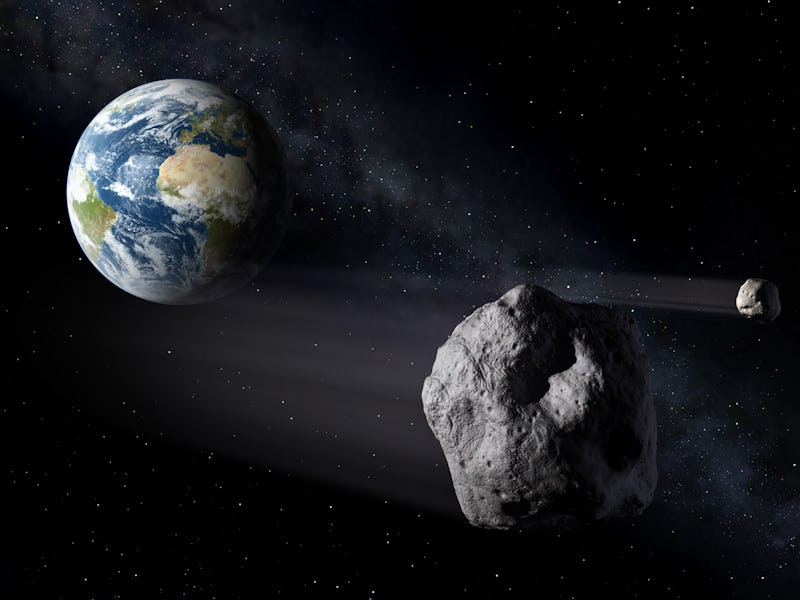In 2029, a Massive Asteroid Will Come Startlingly Close to Earth
It'll be visible with the naked eye.

Few humans realize that the Apophis asteroid, discovered in 2004, is named after the Egyptian god of evil and destruction, who cherished chaos and dwelled in eternal darkness.
In just 12 years, NASA predicts that the 1,000-foot wide space rock will pass within 18,500 miles of Earth, which is less than one-tenth the distance between the Earth and the moon. As Earthlings recognize global Asteroid Day on Friday, it’s a salient reminder that this is startlingly close, but scientists are certain that it will miss our tranquil planet and carry on its endless orbit around the sun. Herein lies the problem: Apophis will return, and when it does, not all scientists are sure that it will miss again.
“We can rule out a collision at the next closest approach with the Earth, but then the orbit will change in a way that is not fully predictable just now, so we cannot predict the behavior on a longer timescale,” Alberto Cellino of the Astrophysical Observatory of Turin, a research facility for Italy’s National Institute for Astrophysics, told Astro Watch.
This is not to say that Cellino thinks Apophis has a good shot at meeting its human-populated maker, but that the orbit of such an irregularly shaped, spinning rock is inherently chaotic, so “ruling out” a future collision may not be possible. Apophis will next return to Earth’s real estate seven years later, in 2036, but NASA’s Center for Near Earth Object Studies is not concerned, saying that the rock will come no closer than 14 million miles from Earth but will probably pass much further away, at around some 35 million miles.
“The tiny residual hazard in 2036 was formally eliminated in 2013,” NASA asteroid expert Jon Giorgini tells Inverse.
The European Space Agency's Philae lander touched down on Rosetta's comet in 2014. Both asteroids and comets are tracked by NASA and other global agencies.
Indeed, 35 million miles sounds like a pretty big miss. Still, part of the uncertainty Cellino speaks of is the Yarkovsky effect, which can nudge an asteroid off its predicted trajectory. Asteroids absorb intense solar rays, and as they spin through space, the manner in which they re-emit this energy can push the asteroid around. This is something NASA scientists observed in 1999, when asteroid RQ36 veered 100 miles from its gravitationally predicted course.
NASA is confident that it has discovered about 90 percent of near-Earth objects 1 kilometer or larger in diameter (about 0.6 miles), which it defines as being within 1.3 astronomical units of the sun, about 120 million miles. Unknown smaller buggers, however, can easily slip in, like the 65-foot wide rock that exploded over Russian skies in 2013.
Bigger rocks imply more death, and a rock of Apophis’s size, estimated to be between 700 and 1,000 feet in diameter, would carry the power of some 500 million tons of TNT. Little Boy, the atomic bomb the United States dropped on Hiroshima in 1945, had the explosive power of 16,000 tons of TNT — which, although dramatic, was dramatically less potent than Apophis’s potential fury. Of course, an Apophis-sized asteroid has a much better chance of landing in the sea than it does on land, and it’s dwarfed by the suspected size of the famous dino-annihilator, which is believed to be at least 15 miles in diameter.
The NASA Dawn mission is currently orbiting and studying Ceres, an asteroid so big, it was labeled a dwarf planet.
However low the probability of a killer asteroid striking Earth is, the U.S. government isn’t taking the callous rocks lightly. In 2015, the U.S. Air Force began building a sophisticated space radar system with aerospace giant Lockheed Martin in the Marshall Islands, located in the middle of the Pacific Ocean. The Air Force calls it the “Space Fence,” and once it goes online in 2018, it will be fixated on tens of thousands of bits of space junk orbiting Earth, as well as chunks of threatening space rocks pummeling towards Earth.
Apophis seems unlikely to smash into Earth anytime soon, but probabilities are probabilities, and experts, however confident in their calculations, remain vigilantly watchful.